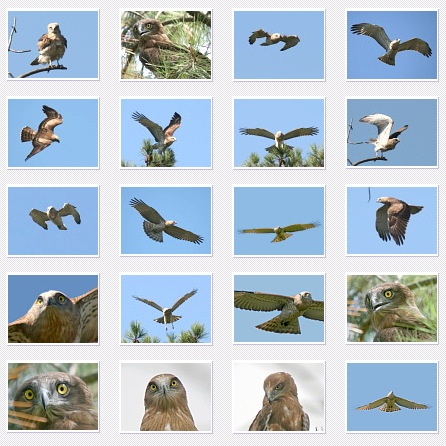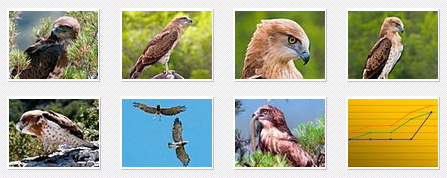All photos of young Short-toed Eagles right after leaving the nests were taken by Françoise Gérardin in Gironde /map/ in 2008:
Category: Regions › France ›
Short-toed Eagles of Le Massif de la Sainte Baume
Oct 29, 2008 / CommentPlease download and read a new article of Richard Frèze on Short-toed Eagle in Provence /map/:
• Richard Frèze, 2008 – Étude de la population de Circaètes sur le massif de la Sainte-Baume et les collines environnantes [Study of Short-toed Eagle population on the Massif de la Sainte-Baume and the surrounding hills] –  (Fr) {rough translation}.
(Fr) {rough translation}.
And also enjoy please some pictures from it:
Circa33 is updated
Sep 21, 2008 / CommentCirca33 des Circaètes en Gironde – Yves Forget’s website about Short-toed Eagles of Gironde /map/, is updated now. New photos by the site author, by Françoise Gérardin and other observers are added and can be viewed right on the front page. If you want to know who made the photo you are viewing, you should just right click on it.
Short-toed Eagles near Marseille
Aug 23, 2008 / CommentThis text about nesting Short-toed Eagles in the environs of Marseille as an example of the species adaptation to urbanization is offered by Richard Frèze:
• Richard Frèze, 2008 – Un Circaète aux portes de Marseille [Short-toed Eagle near Marseille] (Fr). Also you have a possibility to open a PDF  {rough translation} of the article, to view /map//map/ and photos.
{rough translation} of the article, to view /map//map/ and photos.
Biotopes. Haute-Loire (France) -2
May 28, 2008 / CommentShort-toed Eagle population: 75 / 80 pairs.
Please take a look at the map of main survey area /map/. General description and photos can be viewed below:
 Two neighboring breeding sites with eyries 2100 m apart (but more than an hour on foot) in the heart of the Allier gorges, one of the most scenic spots of the Massif Central with a great biodiversity an no measures of protection. The area is a border of the massif of La Margeride and the Velay’s hight plateaux, on the margeridian slope. Here, the valley is 400 m deep with slopes of 60%. Generaly, those birds avoid meeting but some hunting grounds are shared that can cause agonistic behavior.
Two neighboring breeding sites with eyries 2100 m apart (but more than an hour on foot) in the heart of the Allier gorges, one of the most scenic spots of the Massif Central with a great biodiversity an no measures of protection. The area is a border of the massif of La Margeride and the Velay’s hight plateaux, on the margeridian slope. Here, the valley is 400 m deep with slopes of 60%. Generaly, those birds avoid meeting but some hunting grounds are shared that can cause agonistic behavior.
Altitude: 890 m. Exposition: NE.
Altitude: 900 m. Exposition: ENE. Other interesting species: idem.
 Nearest hunting ground: 100 ha of heath, growing after fires. No agricultural activities. Everywhere brooms, thick or sparse, with rocks in places, cliffs and bushes and few pines. The slopes are difficult of access for humans because of the vegetation, rocks and declivity, but very easy for snake eagles, with up-draughts (permitting hang-gliding and thermal soaring).
Nearest hunting ground: 100 ha of heath, growing after fires. No agricultural activities. Everywhere brooms, thick or sparse, with rocks in places, cliffs and bushes and few pines. The slopes are difficult of access for humans because of the vegetation, rocks and declivity, but very easy for snake eagles, with up-draughts (permitting hang-gliding and thermal soaring).
Biotopes. Haute-Loire (France) -1
Apr 22, 2008 / CommentShort-toed Eagle population: 75 / 80 pairs.
Please take a look at the map of main survey area /map/. General description and photos can be viewed below:
15 pairs are surveyed since 1996 in the west of department, on the slopes of the huge hercynian massif of Margeride. Very few human activities in valleys. None intensive agricultural practices on the boarding plateaux (cattle: cow, sheep). Birds nest in V-shaped valleys of the Allier and tributaries, between 700 and 950 m above sea level. Eyries generally on pines, sometimes on firs. Usually nest areas are quiet.
Diet is based on few species: Elaphe longissima (chiefly), Vipera aspis (often), Anguis fragilis (especially during cool and rainy periods), sometimes Coronella. Lizards: Lacerta viridis and Podarcis muralis.
Altitude: 870 m. Exposition: SW. Breeding success rate: 0.66 (n=12).
Nearest hunting ground: Slopes overgrazed by sheep, sparsely covered in broom (Genista purgens), with rocky outcrops.
Altitude: 760 m. Exposition: SSE. Breeding success rate: 0.45 (n=11). Bad rate because site at the crossroad of flight paths of other birds, for hunting areas.
Nearest hunting ground: Between the line of tall trees along a small brook (invisible), and the forest. At the foot of a slope. Sparse heath with few rocks.
Biotopes. Provence (France)
Mar 16, 2008 / CommentContributor: Richard Frèze.
Country: France. Region: Provence-Alpes-Côte d’Azur.
Departement: Bouches-du-Rhône.
Please take a look at the map of main survey area /map/. General description and photos can be viewed below:
A small population of Short-toed Eagles, of about 10/12 pairs, is studied since 2002. They live on the hills located at the east of the town of Marseilles in the area of “Basse Provence”.
The zone occupies an area of approximately 900 km2 but because of strong human activities only a part is favorable to be settled by the birds. Great a difference between hunting and nesting territories can’t be noticed for the region.
The vegetation is made up primarily by scrubland with Kermes Oak (Quercus coccifera) and pine forests with Aleppo Pine (Pinus halepensis) mainly.
The majority of the nests are located on slopes exposed to south/south-east and are built on side branches of Aleppo Pines.
















